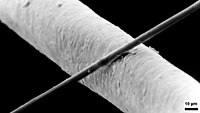
Photo from wikipedia
Abstract This study investigates the high loading rate behavior of adhesively bonded carbon/epoxy composite joints under mode I loading. A computationally guided experimental setup is developed to study the mode-I… Click to show full abstract
Abstract This study investigates the high loading rate behavior of adhesively bonded carbon/epoxy composite joints under mode I loading. A computationally guided experimental setup is developed to study the mode-I behavior of composite joints in the range of quasi-static to high loading rates. A double cantilevered beam specimen with wedge insert type loading setup is used to conduct quasi-static and dynamic experiments. For the dynamic loading, a modified split Hopkinson bar is used to load the sample at high rates. The local deformation field is measured using high Spatio-temporal resolution digital image correlation (DIC). From the experiments, the mode-I energy release rate is calculated from the load, crack extension and crack root rotation data measured using load cell and DIC. A decrease in the initiation fracture toughness with increase in loading rate was observed which is attributed to the strain rate dependent behavior of the epoxy-based film adhesive. For both quasi-static and high loading rates, a mixed adhesive-cohesive failure is observed from the fracture surface analysis.
Journal Title: Composites Science and Technology
Year Published: 2020
Link to full text (if available)
Share on Social Media: Sign Up to like & get
recommendations!